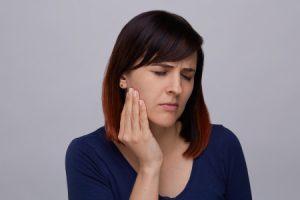Jaw Pain, Popping, or “Clicking”
 Are You Experiencing Jaw Pain?
Are You Experiencing Jaw Pain?
Jaw pain can be a real annoyance. It can be especially disturbing when you have no idea about the cause of the underlying problem. And, since we use our jaws every day for eating and speaking, the pain is usually impossible to ignore.
Different symptoms can be warning signs of a particular problem. However, only a visual examination can confirm a diagnosis and determine the root cause. If you are experiencing jaw pain, please don’t hesitate to contact our office for an appointment.
Symptoms and Possible Causes
Does your jaw open and close smoothly? Or is there popping or clicking? Feel your cheeks while opening and closing. Does each side of the joint feel symmetrical?
If jaw pain is coming from within the joint itself, it’s often called TMJ disorder. TMJ stands for the temporomandibular joint, which connects the mandible (jawbone) to the rest of the skull. This remarkable joint gives us the ability to chew as well as move the lower teeth in virtually any direction. However, when things are “out of whack,” it may cause pain or discomfort. For a smooth-functioning TMJ, the jaw muscles, jawbone, and teeth must all work in unison.
Is the pain worse in the morning or the evenings? Are your teeth experiencing more sensitivity? These symptoms might signal that the underlying cause is bruxism (clenching or grinding of the teeth). Often, this occurs at night while you sleep, causing the pain to be more intense upon first waking. Other times, you may be subconsciously clenching and grinding throughout the day, usually triggered by heightened stress.
Treatment For Jaw Pain
Treatment varies depending on the exact cause of the pain, and we may recommend that you wear a specially designed device such as a splint or nightguard. A splint can help even out your bite and correct jaw alignment problems, whereas a nightguard will prevent clenching and grinding.
If tooth alignment is the underlying cause, it may be a simple adjustment to the teeth themselves. We’ll examine the occlusion (how teeth fit together when closed) to check for problem areas where the teeth may strike against each other, as well as evidence of bruxism. If damage is present, we can build back worn teeth with restorations such as crowns, bridges, inlays, onlay, etc.
![]()
About Yuri Kaneda, DDS
Dr. Yuri Kaneda was born in Japan and immigrated to the US when she was 4 years old with her family. She lived in Ohio, Nebraska, and Illinois before finally settling in the San Diego area. A graduate of Bonita Vista High School, she went on to the University of California Berkeley where she obtained her Bachelors in Microbiology and Immunology. After working for 2 years in growth plate research at University of California San Diego, she went to the University of California San Francisco Dental School for her Doctor of Dental Surgery degree. Upon graduation, she returned to San Diego where she worked as an associate in the practice of Drs. Morimoto and Yaryan, her childhood dentist. She then started her own practice in 1995 and has been at her present location since 1999 which happens to be across the street from her high school!
View all posts by Yuri Kaneda, DDS →
Appointments
To schedule an appointment please email us at [email protected].

